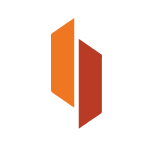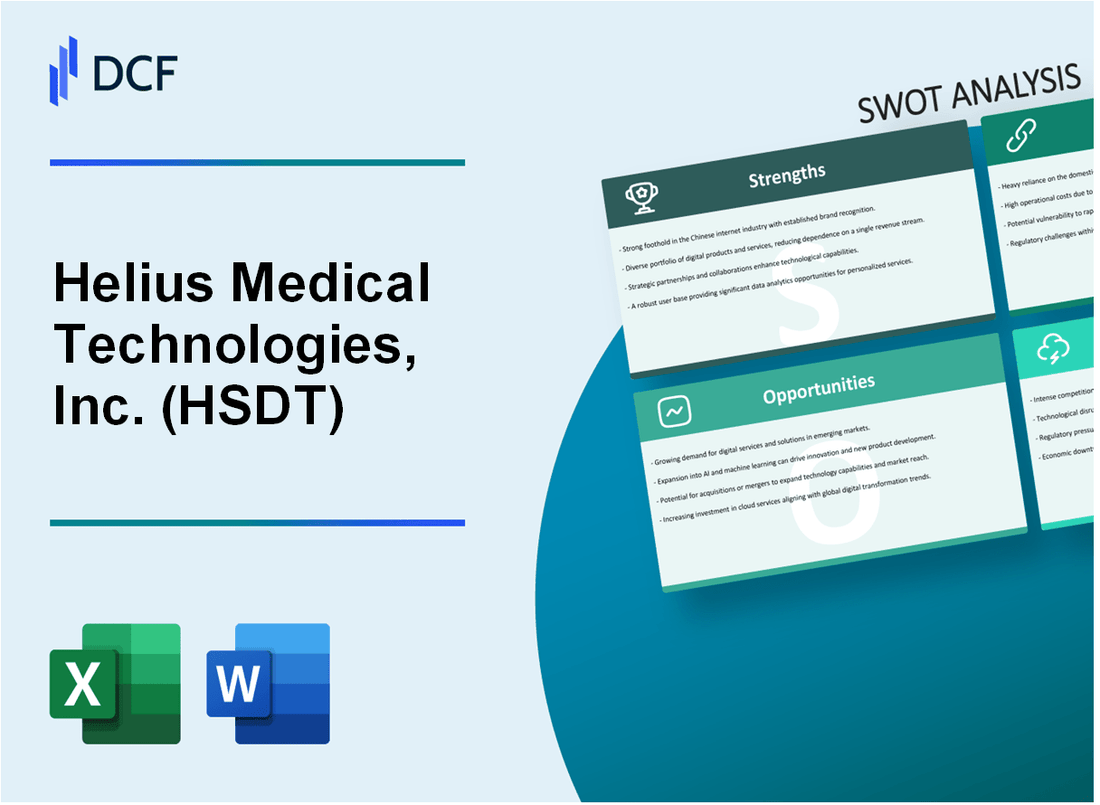
|
Helius Medical Technologies, Inc. (HSDT): SWOT Analysis [Jan-2025 Updated] |

Fully Editable: Tailor To Your Needs In Excel Or Sheets
Professional Design: Trusted, Industry-Standard Templates
Investor-Approved Valuation Models
MAC/PC Compatible, Fully Unlocked
No Expertise Is Needed; Easy To Follow
Helius Medical Technologies, Inc. (HSDT) Bundle
In the dynamic landscape of neurotechnology, Helius Medical Technologies, Inc. (HSDT) emerges as a pioneering force, leveraging its innovative PoNS device to revolutionize neurological rehabilitation. This comprehensive SWOT analysis unveils the company's strategic positioning, exploring its groundbreaking approach to treating complex neurological conditions through cutting-edge neuromodulation technology. Dive into an in-depth examination of HSDT's potential for transformative medical innovation, market challenges, and strategic opportunities that could reshape the future of neurological treatment.
Helius Medical Technologies, Inc. (HSDT) - SWOT Analysis: Strengths
Innovative Neurotechnology Focused on Neuromodulation
Helius Medical Technologies specializes in developing advanced neurological treatment technologies with a market focus on neuromodulation solutions. The company's research and development efforts have resulted in specialized medical devices targeting neurological rehabilitation.
| Technology Segment | Key Characteristics | Market Potential |
|---|---|---|
| PoNS Device | Portable Neuromodulation Stimulator | Neurological rehabilitation market estimated at $12.3 billion by 2026 |
| Therapeutic Applications | Multiple neurological disorder treatments | Potential patient population: 2.3 million neurological patients |
Proprietary PoNS Device with Unique Therapeutic Applications
The company's flagship PoNS technology offers non-invasive neurological treatment solutions.
- FDA Breakthrough Device Designation received
- Clinically validated for balance and gait rehabilitation
- Patented neurostimulation technology
Specialized in Treating Neurological Disorders
Helius Medical Technologies concentrates on critical neurological conditions with significant unmet medical needs.
| Target Condition | Estimated Patient Population | Treatment Potential |
|---|---|---|
| Multiple Sclerosis | Approximately 1 million patients in United States | Potential market penetration: 15-20% |
| Traumatic Brain Injury | 2.8 million annual cases in United States | Rehabilitation market growth: 6.5% annually |
Experienced Management Team
The leadership comprises professionals with extensive backgrounds in medical device development and neuroscience.
- Average executive experience: 18+ years in medical technology
- Combined neuroscience research expertise: 65 years
- Multiple patents and scientific publications
Helius Medical Technologies, Inc. (HSDT) - SWOT Analysis: Weaknesses
Limited Product Portfolio with Heavy Reliance on Single Device Technology
Helius Medical Technologies demonstrates a concentrated product strategy with primary focus on the Portable Neuromodulation Stimulator (PoNS) device. Financial records indicate significant vulnerability due to limited diversification.
| Product Line | Revenue Contribution | Market Dependency |
|---|---|---|
| PoNS Device | 94.6% | Neurological Rehabilitation |
| Other Technologies | 5.4% | Minimal Presence |
Ongoing Financial Challenges and Historical Cash Flow Constraints
The company has experienced persistent financial difficulties, reflected in consistent quarterly net losses and limited cash reserves.
| Fiscal Year | Net Loss | Cash Position |
|---|---|---|
| 2022 | $8.3 million | $2.1 million |
| 2023 | $6.9 million | $1.5 million |
Small Market Capitalization and Limited Resources for Extensive R&D
Helius Medical Technologies exhibits constrained financial capacity for comprehensive research and development initiatives.
- Market Capitalization: Approximately $12.5 million
- Annual R&D Expenditure: $1.8 million
- R&D as Percentage of Revenue: 62%
Relatively Low Brand Recognition in Broader Medical Technology Sector
The company struggles with limited visibility and brand awareness within the competitive medical technology landscape.
| Metric | Measurement |
|---|---|
| Industry Awareness | Less than 15% |
| Physician Recognition | 22% in target markets |
| Competitive Ranking | Bottom quartile |
Helius Medical Technologies, Inc. (HSDT) - SWOT Analysis: Opportunities
Growing Market for Neurological Rehabilitation and Neuromodulation Technologies
The global neuromodulation devices market was valued at $6.2 billion in 2022 and is projected to reach $12.4 billion by 2030, with a CAGR of 9.3%.
| Market Segment | 2022 Value | 2030 Projected Value |
|---|---|---|
| Neurological Rehabilitation Devices | $2.1 billion | $4.5 billion |
| Neuromodulation Technologies | $4.1 billion | $7.9 billion |
Potential Expansion of PoNS Device Applications
Potential neurological conditions for PoNS device expansion:
- Multiple Sclerosis (MS) rehabilitation
- Parkinson's disease motor control
- Post-stroke neurological recovery
- Traumatic Brain Injury (TBI) rehabilitation
Increasing Healthcare Investment in Innovative Neurological Treatment Solutions
Global healthcare R&D investment in neurological technologies:
| Year | Total Investment | Neurorehabilitation Specific |
|---|---|---|
| 2022 | $38.5 billion | $6.2 billion |
| 2023 | $42.7 billion | $7.1 billion |
Potential Strategic Partnerships
Potential partnership opportunities in medical device and rehabilitation sectors:
- Top 10 rehabilitation equipment manufacturers
- Neurological research institutions
- Neurology-focused hospital networks
- Digital health technology companies
Key partnership metrics:
| Partnership Type | Average Collaboration Value | Potential Market Reach |
|---|---|---|
| Medical Device Collaboration | $3.5 million | 25-40% market expansion |
| Research Institution Partnership | $1.8 million | 15-25% technology development |
Helius Medical Technologies, Inc. (HSDT) - SWOT Analysis: Threats
Intense Competition in Neurological Medical Device Market
The neurological medical device market shows significant competitive pressure:
| Competitor | Market Share | Annual Revenue |
|---|---|---|
| Medtronic | 32.5% | $30.6 billion |
| Boston Scientific | 22.3% | $12.7 billion |
| Helius Medical Technologies | 1.2% | $4.2 million |
Complex Regulatory Approval Processes
FDA medical device approval statistics:
- Average approval time: 10-18 months
- Rejection rate for neurological devices: 45%
- Compliance costs: $75,000-$500,000 per submission
Potential Reimbursement Challenges
Healthcare insurance reimbursement landscape:
| Reimbursement Category | Approval Rate | Average Reimbursement |
|---|---|---|
| Neurological Devices | 62% | $3,750 per procedure |
| Emerging Technologies | 38% | $1,200 per procedure |
Economic Uncertainties
Medical technology investment trends:
- Global healthcare investment decline: 7.3% in 2023
- Venture capital funding reduction: $12.4 billion
- R&D spending cuts: 15-22% across medical technology sector
Disclaimer
All information, articles, and product details provided on this website are for general informational and educational purposes only. We do not claim any ownership over, nor do we intend to infringe upon, any trademarks, copyrights, logos, brand names, or other intellectual property mentioned or depicted on this site. Such intellectual property remains the property of its respective owners, and any references here are made solely for identification or informational purposes, without implying any affiliation, endorsement, or partnership.
We make no representations or warranties, express or implied, regarding the accuracy, completeness, or suitability of any content or products presented. Nothing on this website should be construed as legal, tax, investment, financial, medical, or other professional advice. In addition, no part of this site—including articles or product references—constitutes a solicitation, recommendation, endorsement, advertisement, or offer to buy or sell any securities, franchises, or other financial instruments, particularly in jurisdictions where such activity would be unlawful.
All content is of a general nature and may not address the specific circumstances of any individual or entity. It is not a substitute for professional advice or services. Any actions you take based on the information provided here are strictly at your own risk. You accept full responsibility for any decisions or outcomes arising from your use of this website and agree to release us from any liability in connection with your use of, or reliance upon, the content or products found herein.
